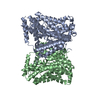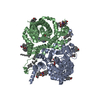+ Open data
Open data
- Basic information
Basic information
| Entry |  | |||||||||||||||
|---|---|---|---|---|---|---|---|---|---|---|---|---|---|---|---|---|
| Title | Structure of NaCT-succ complex | |||||||||||||||
 Map data Map data | Sharpened map of NaCT-succinate in Ci-Ci conformation | |||||||||||||||
 Sample Sample |
| |||||||||||||||
 Keywords Keywords | Na(+)/citrate cotransporter(NaCT) / Solute carries / Elevator type alternating access / membrane protein / TRANSPORT PROTEIN | |||||||||||||||
| Function / homology |  Function and homology information Function and homology informationoxaloacetate transport / organic acid:sodium symporter activity / fumarate transport / succinate transport / sodium:dicarboxylate symporter activity / citrate transmembrane transporter activity / citrate transport / Sodium-coupled sulphate, di- and tri-carboxylate transporters / alpha-ketoglutarate transport / succinate transmembrane transporter activity ...oxaloacetate transport / organic acid:sodium symporter activity / fumarate transport / succinate transport / sodium:dicarboxylate symporter activity / citrate transmembrane transporter activity / citrate transport / Sodium-coupled sulphate, di- and tri-carboxylate transporters / alpha-ketoglutarate transport / succinate transmembrane transporter activity / cellular response to lithium ion / transmembrane transport / nucleoplasm / identical protein binding / plasma membrane / cytosol Similarity search - Function | |||||||||||||||
| Biological species |  Homo sapiens (human) Homo sapiens (human) | |||||||||||||||
| Method | single particle reconstruction / cryo EM / Resolution: 2.33 Å | |||||||||||||||
 Authors Authors | Li Y / Wang DN / Mindell JA / Rice WJ / Song J / Mikusevic V / Marden JJ / Becerril A / Kuang H / Wang B | |||||||||||||||
| Funding support |  United States, 4 items United States, 4 items
| |||||||||||||||
 Citation Citation |  Journal: Nat Struct Mol Biol / Year: 2025 Journal: Nat Struct Mol Biol / Year: 2025Title: Substrate translocation and inhibition in human dicarboxylate transporter NaDC3. Authors: Yan Li / Jinmei Song / Vedrana Mikusevic / Jennifer J Marden / Alissa Becerril / Huihui Kuang / Bing Wang / William J Rice / Joseph A Mindell / Da-Neng Wang /  Abstract: The human high-affinity sodium-dicarboxylate cotransporter (NaDC3) imports various substrates into the cell as tricarboxylate acid cycle intermediates, lipid biosynthesis precursors and signaling ...The human high-affinity sodium-dicarboxylate cotransporter (NaDC3) imports various substrates into the cell as tricarboxylate acid cycle intermediates, lipid biosynthesis precursors and signaling molecules. Understanding the cellular signaling process and developing inhibitors require knowledge of the structural basis of the dicarboxylate specificity and inhibition mechanism of NaDC3. To this end, we determined the cryo-electron microscopy structures of NaDC3 in various dimers, revealing the protomer in three conformations: outward-open C, outward-occluded C and inward-open C. A dicarboxylate is first bound and recognized in C and how the substrate interacts with NaDC3 in C likely helps to further determine the substrate specificity. A phenylalanine from the scaffold domain interacts with the bound dicarboxylate in the C state and modulates the kinetic barrier to the transport domain movement. Structural comparison of an inhibitor-bound structure of NaDC3 to that of the sodium-dependent citrate transporter suggests ways for making an inhibitor that is specific for NaDC3. | |||||||||||||||
| History |
|
- Structure visualization
Structure visualization
| Supplemental images |
|---|
- Downloads & links
Downloads & links
-EMDB archive
| Map data |  emd_42620.map.gz emd_42620.map.gz | 52.7 MB |  EMDB map data format EMDB map data format | |
|---|---|---|---|---|
| Header (meta data) |  emd-42620-v30.xml emd-42620-v30.xml emd-42620.xml emd-42620.xml | 26.4 KB 26.4 KB | Display Display |  EMDB header EMDB header |
| FSC (resolution estimation) |  emd_42620_fsc.xml emd_42620_fsc.xml | 8.4 KB | Display |  FSC data file FSC data file |
| Images |  emd_42620.png emd_42620.png | 92.5 KB | ||
| Masks |  emd_42620_msk_1.map emd_42620_msk_1.map | 64 MB |  Mask map Mask map | |
| Filedesc metadata |  emd-42620.cif.gz emd-42620.cif.gz | 7.7 KB | ||
| Others |  emd_42620_additional_1.map.gz emd_42620_additional_1.map.gz emd_42620_half_map_1.map.gz emd_42620_half_map_1.map.gz emd_42620_half_map_2.map.gz emd_42620_half_map_2.map.gz | 31.2 MB 51.9 MB 51.9 MB | ||
| Archive directory |  http://ftp.pdbj.org/pub/emdb/structures/EMD-42620 http://ftp.pdbj.org/pub/emdb/structures/EMD-42620 ftp://ftp.pdbj.org/pub/emdb/structures/EMD-42620 ftp://ftp.pdbj.org/pub/emdb/structures/EMD-42620 | HTTPS FTP |
-Validation report
| Summary document |  emd_42620_validation.pdf.gz emd_42620_validation.pdf.gz | 877.5 KB | Display |  EMDB validaton report EMDB validaton report |
|---|---|---|---|---|
| Full document |  emd_42620_full_validation.pdf.gz emd_42620_full_validation.pdf.gz | 877.1 KB | Display | |
| Data in XML |  emd_42620_validation.xml.gz emd_42620_validation.xml.gz | 16.3 KB | Display | |
| Data in CIF |  emd_42620_validation.cif.gz emd_42620_validation.cif.gz | 21.1 KB | Display | |
| Arichive directory |  https://ftp.pdbj.org/pub/emdb/validation_reports/EMD-42620 https://ftp.pdbj.org/pub/emdb/validation_reports/EMD-42620 ftp://ftp.pdbj.org/pub/emdb/validation_reports/EMD-42620 ftp://ftp.pdbj.org/pub/emdb/validation_reports/EMD-42620 | HTTPS FTP |
-Related structure data
| Related structure data |  8uvhMC  8uvbC  8uvcC  8uvdC  8uveC  8uvfC  8uvgC  8uviC C: citing same article ( M: atomic model generated by this map |
|---|---|
| Similar structure data | Similarity search - Function & homology  F&H Search F&H Search |
- Links
Links
| EMDB pages |  EMDB (EBI/PDBe) / EMDB (EBI/PDBe) /  EMDataResource EMDataResource |
|---|
- Map
Map
| File |  Download / File: emd_42620.map.gz / Format: CCP4 / Size: 64 MB / Type: IMAGE STORED AS FLOATING POINT NUMBER (4 BYTES) Download / File: emd_42620.map.gz / Format: CCP4 / Size: 64 MB / Type: IMAGE STORED AS FLOATING POINT NUMBER (4 BYTES) | ||||||||||||||||||||||||||||||||||||
|---|---|---|---|---|---|---|---|---|---|---|---|---|---|---|---|---|---|---|---|---|---|---|---|---|---|---|---|---|---|---|---|---|---|---|---|---|---|
| Annotation | Sharpened map of NaCT-succinate in Ci-Ci conformation | ||||||||||||||||||||||||||||||||||||
| Projections & slices | Image control
Images are generated by Spider. | ||||||||||||||||||||||||||||||||||||
| Voxel size | X=Y=Z: 0.825 Å | ||||||||||||||||||||||||||||||||||||
| Density |
| ||||||||||||||||||||||||||||||||||||
| Symmetry | Space group: 1 | ||||||||||||||||||||||||||||||||||||
| Details | EMDB XML:
|
-Supplemental data
-Mask #1
| File |  emd_42620_msk_1.map emd_42620_msk_1.map | ||||||||||||
|---|---|---|---|---|---|---|---|---|---|---|---|---|---|
| Projections & Slices |
| ||||||||||||
| Density Histograms |
-Additional map: Unsharpened map of NaCT-succinate in Ci-Ci conformation
| File | emd_42620_additional_1.map | ||||||||||||
|---|---|---|---|---|---|---|---|---|---|---|---|---|---|
| Annotation | Unsharpened map of NaCT-succinate in Ci-Ci conformation | ||||||||||||
| Projections & Slices |
| ||||||||||||
| Density Histograms |
-Half map: Half map B of NaCT-succinate in Ci-Ci conformation
| File | emd_42620_half_map_1.map | ||||||||||||
|---|---|---|---|---|---|---|---|---|---|---|---|---|---|
| Annotation | Half map B of NaCT-succinate in Ci-Ci conformation | ||||||||||||
| Projections & Slices |
| ||||||||||||
| Density Histograms |
-Half map: Half map A of NaCT-succinate in Ci-Ci conformation
| File | emd_42620_half_map_2.map | ||||||||||||
|---|---|---|---|---|---|---|---|---|---|---|---|---|---|
| Annotation | Half map A of NaCT-succinate in Ci-Ci conformation | ||||||||||||
| Projections & Slices |
| ||||||||||||
| Density Histograms |
- Sample components
Sample components
-Entire : Dimer of NaCT complex in succinate
| Entire | Name: Dimer of NaCT complex in succinate |
|---|---|
| Components |
|
-Supramolecule #1: Dimer of NaCT complex in succinate
| Supramolecule | Name: Dimer of NaCT complex in succinate / type: complex / ID: 1 / Parent: 0 / Macromolecule list: all |
|---|---|
| Source (natural) | Organism:  Homo sapiens (human) Homo sapiens (human) |
| Molecular weight | Theoretical: 63.062 KDa |
-Macromolecule #1: Solute carrier family 13 member 5
| Macromolecule | Name: Solute carrier family 13 member 5 / type: protein_or_peptide / ID: 1 / Details: Solute carrier family 13 member 5 / Number of copies: 2 / Enantiomer: LEVO |
|---|---|
| Source (natural) | Organism:  Homo sapiens (human) Homo sapiens (human) |
| Molecular weight | Theoretical: 63.110812 KDa |
| Recombinant expression | Organism:  Trichoplusia ni (cabbage looper) Trichoplusia ni (cabbage looper) |
| Sequence | String: MASALSYVSK FKSFVILFVT PLLLLPLVIL MPAKFVRCAY VIILMAIYWC TEVIPLAVTS LMPVLLFPLF QILDSRQVCV QYMKDTNML FLGGLIVAVA VERWNLHKRI ALRTLLWVGA KPARLMLGFM GVTALLSMWI SNTATTAMMV PIVEAILQQM E ATSAATEA ...String: MASALSYVSK FKSFVILFVT PLLLLPLVIL MPAKFVRCAY VIILMAIYWC TEVIPLAVTS LMPVLLFPLF QILDSRQVCV QYMKDTNML FLGGLIVAVA VERWNLHKRI ALRTLLWVGA KPARLMLGFM GVTALLSMWI SNTATTAMMV PIVEAILQQM E ATSAATEA GLELVDKGKA KELPGSQVIF EGPTLGQQED QERKRLCKAM TLCICYAASI GGTATLTGTG PNVVLLGQMN EL FPDSKDL VNFASWFAFA FPNMLVMLLF AWLWLQFVYM RFNFKKSWGC GLESKKNEKA ALKVLQEEYR KLGPLSFAEI NVL ICFFLL VILWFSRDPG FMPGWLTVAW VEGETKYVSD ATVAIFVATL LFIVPSQKPK FNFRSQTEEE RKTPFYPPPL LDWK VTQEK VPWGIVLLLG GGFALAKGSE ASGLSVWMGK QMEPLHAVPP AAITLILSLL VAVFTECTSN VATTTLFLPI FASMS RSIG LNPLYIMLPC TLSASFAFML PVATPPNAIV FTYGHLKVAD MVKTGVIMNI IGVFCVFLAV NTWGRAIFDL DHFPDW ANV THIET UniProtKB: Na(+)/citrate cotransporter |
-Experimental details
-Structure determination
| Method | cryo EM |
|---|---|
 Processing Processing | single particle reconstruction |
| Aggregation state | particle |
- Sample preparation
Sample preparation
| Concentration | 1 mg/mL | ||||||||||||
|---|---|---|---|---|---|---|---|---|---|---|---|---|---|
| Buffer | pH: 7.5 Component:
| ||||||||||||
| Grid | Model: UltrAuFoil R1.2/1.3 / Material: GOLD / Mesh: 300 / Support film - Material: GOLD / Support film - topology: HOLEY / Support film - Film thickness: 50 / Pretreatment - Type: GLOW DISCHARGE / Pretreatment - Time: 25 sec. / Pretreatment - Atmosphere: AIR / Pretreatment - Pressure: 0.026000000000000002 kPa / Details: Hold 10s before glow discharge | ||||||||||||
| Vitrification | Cryogen name: ETHANE / Chamber humidity: 100 % / Chamber temperature: 281.15 K / Instrument: FEI VITROBOT MARK IV | ||||||||||||
| Details | This sample was performed an amphipol(PMAL-C8) exchange at a 1:5 protein:amphipol weight ratio |
- Electron microscopy
Electron microscopy
| Microscope | FEI TITAN KRIOS |
|---|---|
| Temperature | Min: 80.0 K / Max: 80.0 K |
| Alignment procedure | Coma free - Residual tilt: 0.05 mrad |
| Specialist optics | Energy filter - Name: GIF Bioquantum / Energy filter - Slit width: 20 eV |
| Image recording | Film or detector model: GATAN K3 BIOQUANTUM (6k x 4k) / Digitization - Dimensions - Width: 5760 pixel / Digitization - Dimensions - Height: 4092 pixel / Number grids imaged: 1 / Number real images: 10359 / Average exposure time: 2.5 sec. / Average electron dose: 52.75 e/Å2 Details: 5868 untilted images and 4491 40 degrees tilted images were collected in super resolution mode at 50 frames per micrograph |
| Electron beam | Acceleration voltage: 300 kV / Electron source:  FIELD EMISSION GUN FIELD EMISSION GUN |
| Electron optics | C2 aperture diameter: 70.0 µm / Calibrated defocus max: 3.0 µm / Calibrated defocus min: 0.8 µm / Calibrated magnification: 105000 / Illumination mode: FLOOD BEAM / Imaging mode: BRIGHT FIELD / Cs: 2.7 mm / Nominal defocus max: 1.6 µm / Nominal defocus min: 1.2 µm / Nominal magnification: 105000 |
| Sample stage | Specimen holder model: FEI TITAN KRIOS AUTOGRID HOLDER / Cooling holder cryogen: NITROGEN |
| Experimental equipment |  Model: Titan Krios / Image courtesy: FEI Company |
+ Image processing
Image processing
-Atomic model buiding 1
| Initial model | PDB ID: Chain - Chain ID: AB / Chain - Residue range: 1-568 / Chain - Source name: PDB / Chain - Initial model type: experimental model / Details: The whole model was used as an initial model |
|---|---|
| Details | Initial local fitting was done using Chimera and then coot was used for ajustment. |
| Refinement | Space: REAL / Protocol: OTHER / Overall B value: 52.62 / Target criteria: cross-correlation coefficient |
| Output model |  PDB-8uvh: |
 Movie
Movie Controller
Controller











 Z (Sec.)
Z (Sec.) Y (Row.)
Y (Row.) X (Col.)
X (Col.)






















































